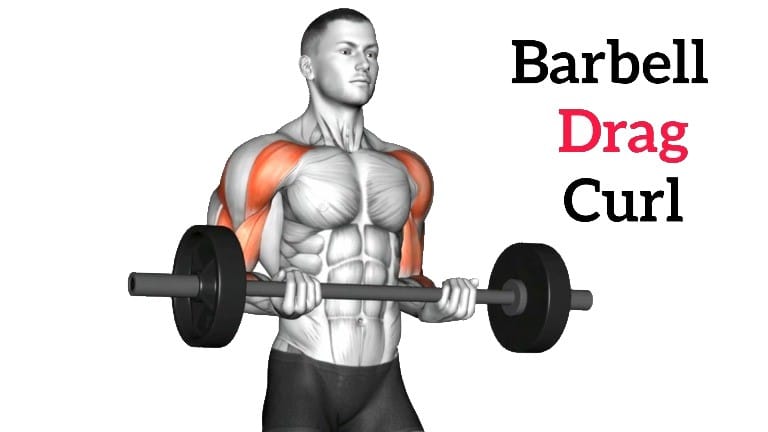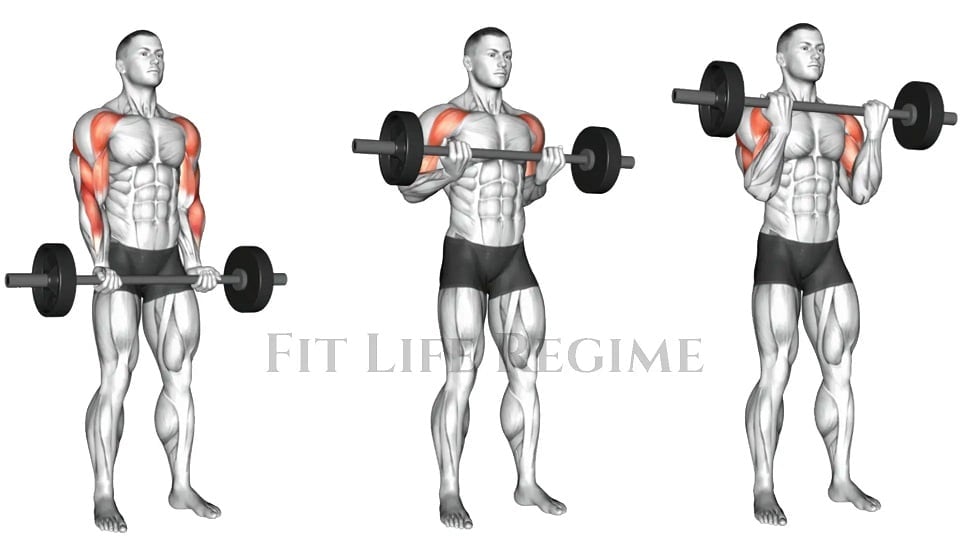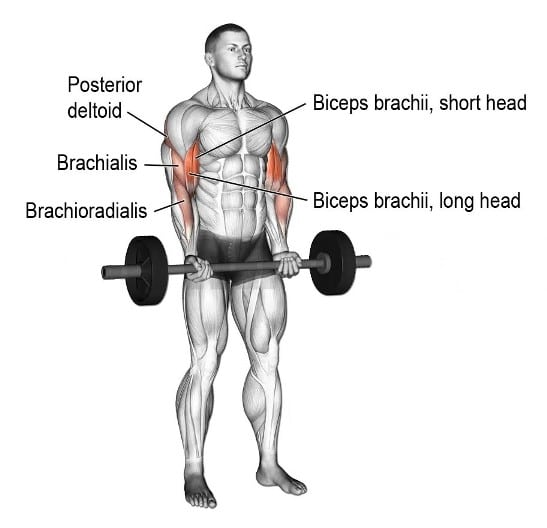The barbell drag curl is a fantastic exercise for building sleeve-splitting arms, but I know many lifters struggle to get it right – especially at the start.
Awkward starts, elbow drift, and losing tension… these common problems can steal your gains and frustrate you.
Do not worry. I’m here to help.
In this blog, we will provide a guide on the following topics:
- What is barbell drag curl
- Muscles worked
- How to do
- The best variations

- What is Barbell Drag Curl
- Barbell Drag Curl Muscles Worked
- How To Do Barbell Drag Curl
- Proper Form and Tips
- Best Variations Of Barbell Drag Curl
- 1. EZ Bar Drag Curl
- 2. Barbell Reverse Drag Curl
- 3. Drag Curl With Hold
- The Best Alternatives for Barbell Drag Curl
- FAQs
- Barbell curl vs drag curl
- How many barbell curls should i do?
- Are barbell drag curls effective?
- Do drag curls target the long head?
- Takeaways
What is Barbell Drag Curl
The barbell drag curl is a powerful biceps isolation exercise designed to target the long head of your biceps. It not only targets the biceps, but also trains the forearms, and brachioradialis muscles.
It is performed by holding a barbell close to the body, dragging and curling it towards the shoulder in a smooth, controlled motion.
The barbell drags curl differs from traditional bicep curls because it involves using the brachioradialis and brachialis muscles in addition to the biceps.
You can perform this exercise using either a standard barbell or an EZ curl bar.

Barbell Drag Curl Muscles Worked
The barbell drag curls primarily activate both the heads of the biceps brachii. It focuses on the “peak” or long head of the biceps.
The secondarily worked is your brachialis, a muscle in your biceps that lies beneath your biceps brachii. It also activates your brachioradialis, the most prominent muscle in your forearm.
The drag curls also work your abs & back, as a stabling muscle of your body during the curling motion.

How To Do Barbell Drag Curl
- Stand upright with your feet shoulder-width apart and a slight bend in your knees.
- Grasp the barbell slightly wider than shoulder-width apart, with your palms facing upward.
- Hold the barbell close to your body, with your arms extended and the bar touching your thighs.
- Keeping your elbows close to your sides, slowly drag the bar up.
- As the bar reaches your waist, curl it upwards towards your chest.
- Pause at the top of the curl, then slowly lower the bar back down to the starting position.
- Repeat for 8–12 reps.
Proper Form and Tips
- Keep Your Elbows Close to Your Sides
- Perform the barbell drag curl with slow and controlled movements, avoiding swinging the weight.
- Pay attention to the negative part of the movement and slowly lower the bar back down to the starting position.
- It is important to start with a lighter weight and gradually increase the weight as you become more comfortable with the exercise.
- Keep your upper body upright and stable. Avoid leaning back to help lift the weight.
- Exhale on the exertion (curling up) and inhale as you lower the weight.
- I really concentrate on squeezing those biceps with each rep.
- Always warm up before performing the drag curl, including a few light sets to warm up your muscles.
Best Variations Of Barbell Drag Curl
You can perform this drag curl with different bars and grips for additional variations.
1. EZ Bar Drag Curl
The EZ bar drag curl is a variation of the bicep drag curl exercise that primarily targets the biceps and forearm.
The exercise is performed with an EZ bar, which is a barbell with a unique shape that allows for a more comfortable grip.
Using an EZ bar places the wrists in a semi-supinated position, reducing the strain on the connective tissue and preventing the forearms from being forced into an unnatural level of supination.

How To Do It
- Stand with your feet shoulder-width apart and hold the EZ bar.
- Keep your elbows close to your sides as you drag the bar up.
- Pause briefly at the top of the curl, then lower the bar back down to the starting position.
- Repeat for the desired number of reps.
2. Barbell Reverse Drag Curl
The barbell reverses drag curl, a variation of the barbell curl that targets the brachioradialis, biceps, and forearms.
In this exercise, you hold the barbell in a reverse grip, with your palms facing down, and curl the weight up towards your chest.
Compared to the regular reverse curl, reverse drag curls help you maintain tension on the target muscles because you cannot swing the weight up with your shoulders.
Read More: Reverse Bicep Curl: Muscle Worked, Benefits, Variations
How to Do It
- Stand with your feet shoulder-width apart and hold the barbell with a reverse grip (palms facing down).
- Keep your elbows close to your sides and maintain a straight back throughout the entire movement.
- Slowly drag and curl the barbell up towards your chest.
- Pause at the top of the movement and then slowly lower the bar back down to the starting position.
3. Drag Curl With Hold
The drag curls hold involves holding the weight at the top of the movement for a set amount of time.
This exercise can help to increase the time under tension for the biceps, brachioradialis, and forearms, leading to increased muscle activation and growth.
How to Do It
- Hold the barbell in your underhand and keep your elbows close to your sides.
- Drag the barbell up towards your chest.
- Hold the weight at the movement’s top for a set period, typically 5–10 seconds.
- Slowly lower the barbell back to the starting position.
The Best Alternatives for Barbell Drag Curl
If you are looking for an alternative to the barbell drag curl, here are a few exercises that can help target similar muscle groups:
- Dumbbell Hammer Curl
- Concentration Curl
- Incline Dumbbell Curl
- Preacher Curl
- Cable Curl
FAQs
Barbell curl vs drag curl
The Barbell curl is a traditional bicep curl exercise that curls the weight up towards the chest. This exercise primarily targets the biceps.
The barbell curl is performed by keeping the elbows close to the sides and dragging the barbell up towards the chest. This exercise targets not only the biceps but also the brachioradialis and the forearms.
How many barbell curls should i do?
The number of barbell curls you should do will depend on your goals and fitness level.
- For General Fitness: 2–3 sets of 8–12 repetitions with a moderate weight.
- For Muscle Building: 3–4 sets of 6–8 repetitions with a heavy weight.
- For Endurance Training: 3–4 sets of 15–20 repetitions with a lighter weight.
Are barbell drag curls effective?
Yes, barbell drag curls can effectively target the biceps, brachioradialis, and forearms.
It helps to stimulate a greater number of muscle fibers.
Do drag curls target the long head?
Yes, the barbell drag curl can target the long head of the biceps muscle.
The unique grip and movement pattern can help target the long head better than traditional bicep curls.
Takeaways
Barbell drag curl is a great exercise for targeting the biceps and forearms, improving grip strength, and increasing muscle activation and control.
When incorporating it into your workout routine, be sure to use proper form and start with lighter weights before gradually increasing the weight.
References
- Marcolin G, Panizzolo FA, Petrone N, Moro T, Grigoletto D, Piccolo D, Paoli A. Differences in electromyographic activity of biceps brachii and brachioradialis while performing three variants of curl. PeerJ. 2018 Jul 13;6:e5165. doi: 10.7717/peerj.5165. PMID: 30013836; PMCID: PMC6047503.
- Naito A. Electrophysiological studies of muscles in the human upper limb: the biceps brachii. Anat Sci Int. 2004 Mar;79(1):11-20. doi: 10.1111/j.1447-073x.2004.00064.x. PMID: 15088788.
- Nakazawa K, Kawakami Y, Fukunaga T, Yano H, Miyashita M. Differences in activation patterns in elbow flexor muscles during isometric, concentric and eccentric contractions. Eur J Appl Physiol Occup Physiol. 1993;66(3):214-20. doi: 10.1007/BF00235096. PMID: 8477676.

Manish brings over 10 years of hands-on experience in weight lifting and fat loss to fitness coaching. He specializes in gym-based training and has a lot of knowledge about exercise, lifting technique, biomechanics, and more.
Through “Fit Life Regime,” he generously shares the insights he’s gained over a decade in the field. His goal is to equip others with the knowledge to start their own fitness journey.
